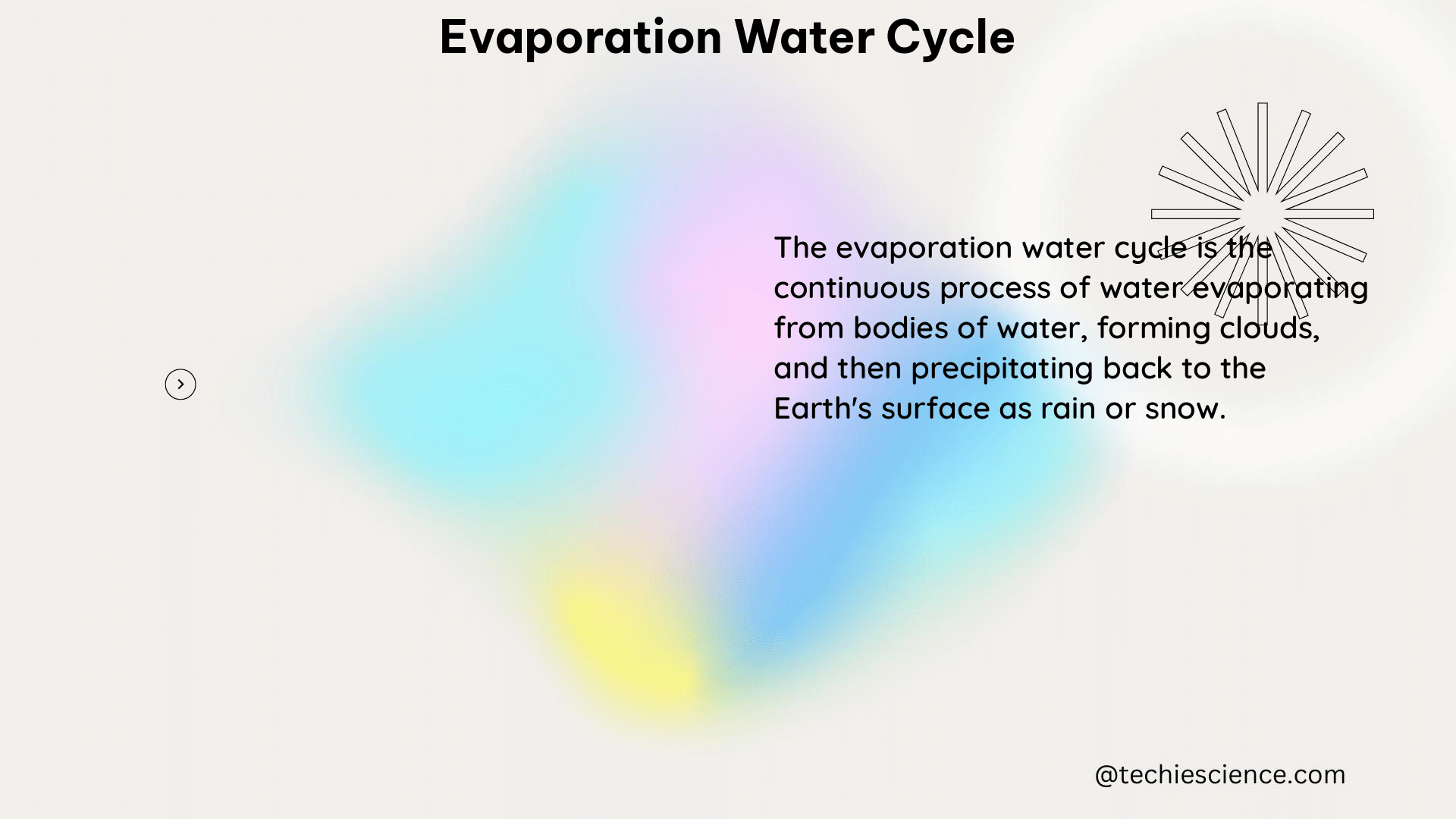The water cycle, also known as the hydrologic cycle, is a continuous process by which water circulates between the Earth’s oceans, atmosphere, and land. Evaporation, a crucial component of this cycle, is the transformation of water from a liquid state to a gaseous state, primarily driven by solar radiation and other factors such as air temperature, vapor pressure, wind, and atmospheric pressure.
Understanding the Evaporation Process
Evaporation is a physical process governed by the principles of thermodynamics. When water molecules at the surface of a body of water absorb enough energy, typically in the form of solar radiation, they can overcome the intermolecular forces that hold them together in the liquid state and transition into the gaseous state, forming water vapor.
The rate of evaporation is influenced by several factors:
-
Temperature: As the temperature of the water increases, the kinetic energy of the water molecules also increases, making it easier for them to escape the liquid phase and enter the gaseous state.
-
Vapor Pressure: The difference between the vapor pressure of the water surface and the vapor pressure of the surrounding air is a key driver of evaporation. The greater the difference, the faster the evaporation rate.
-
Wind Speed: Increased wind speed helps to remove the water vapor from the surface, creating a concentration gradient that promotes further evaporation.
-
Surface Area: The larger the surface area of the water body, the greater the area from which water can evaporate, leading to a higher overall evaporation rate.
-
Salinity: The presence of dissolved salts in water can affect the vapor pressure and, consequently, the evaporation rate. Generally, saltwater has a lower evaporation rate compared to freshwater.
Quantifying Evaporation Rates

Evaporation rates can be measured and quantified using various methods, including:
-
Pan Evaporation: This method involves measuring the amount of water lost from a standardized pan over a specific time period, typically a day or a week. The pan evaporation rate can then be used to estimate the evaporation from larger water bodies.
-
Eddy Covariance: This technique uses fast-response sensors to measure the vertical fluxes of water vapor and heat, allowing for direct measurement of the evaporation rate.
-
Bowen Ratio: This method relies on the relationship between the sensible and latent heat fluxes to estimate the evaporation rate.
-
Water Budget: By measuring the inflows and outflows of a water body, the evaporation rate can be calculated as the residual term in the water budget equation.
According to NASA’s data, the global ocean evaporation rate is approximately 4 million cubic kilometers per year, while global precipitation over the ocean is about 3.4 million cubic kilometers per year, resulting in a net gain of about 0.6 million cubic kilometers per year for the ocean.
The Role of Evaporation in the Water Cycle
Evaporation plays a crucial role in the water cycle, as it is responsible for the transfer of water from the Earth’s surface to the atmosphere. This process is essential for the formation of clouds and the subsequent precipitation that replenishes freshwater sources, such as rivers, lakes, and groundwater.
The latent heat released during the condensation of water vapor is an essential part of the Earth’s heat balance, coupling the planet’s energy and water cycles. Evaporation from the oceans also helps to cool the surface, partially buffering the greenhouse effect caused by increasing carbon dioxide and other gases.
Simulating Evaporation in the Classroom
To better understand the factors that influence the evaporation water cycle, students can conduct simple experiments to simulate different weather conditions and observe their effects on the rate of evaporation. Some examples of these experiments include:
-
Varying Temperature: Students can use a lamp or other heat source to represent the Sun and observe how changes in temperature affect the rate of evaporation from a water source.
-
Varying Wind Speed: By using a fan or hairdryer to represent wind, students can investigate how changes in air movement influence the evaporation rate.
-
Varying Surface Area: Students can compare the evaporation rates from water sources with different surface areas, such as a shallow pan and a deep container.
-
Varying Salinity: Students can compare the evaporation rates of freshwater and saltwater to observe the effect of dissolved salts on the process.
By conducting multiple trials and calculating averages, students can make interpretations about their data and better understand the complex interplay of factors that govern the evaporation water cycle.
Conclusion
The evaporation water cycle is a fundamental process that drives the continuous circulation of water on our planet. Understanding the underlying physics, chemistry, and biology of evaporation is crucial for managing water resources, predicting climate patterns, and developing sustainable water management strategies. By exploring the evaporation water cycle through hands-on experiments and data analysis, students can gain a deeper appreciation for the intricate workings of the Earth’s hydrological system.
References
- The Global Water Cycle – Woods Hole Oceanographic Institution
- NASA Earth Science: Water Cycle | Precipitation Education
- Water Cycle – National Weather Service
- Evaporation, Condensation, and the Water Cycle – California State Polytechnic University, Pomona
- The Water Cycle | Precipitation Education – NASA GPM

The lambdageeks.com Core SME Team is a group of experienced subject matter experts from diverse scientific and technical fields including Physics, Chemistry, Technology,Electronics & Electrical Engineering, Automotive, Mechanical Engineering. Our team collaborates to create high-quality, well-researched articles on a wide range of science and technology topics for the lambdageeks.com website.
All Our Senior SME are having more than 7 Years of experience in the respective fields . They are either Working Industry Professionals or assocaited With different Universities. Refer Our Authors Page to get to know About our Core SMEs.